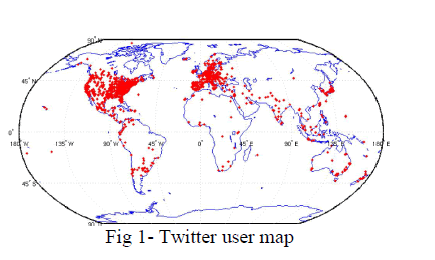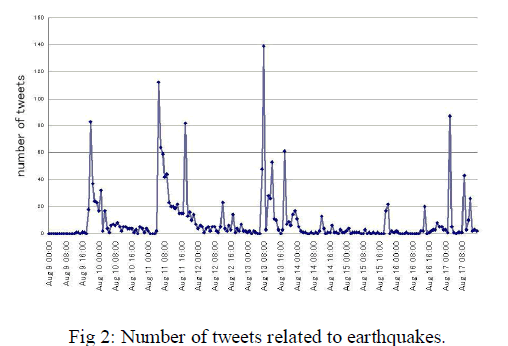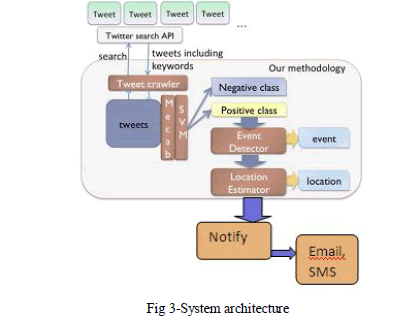ISSN ONLINE(2320-9801) PRINT (2320-9798)
ISSN ONLINE(2320-9801) PRINT (2320-9798)
Anitha.R1 , S.Selvakumar 2 , V.Anusha Sowbarnika3, N.Varatharajan3
|
| Related article at Pubmed, Scholar Google |
Visit for more related articles at International Journal of Innovative Research in Computer and Communication Engineering
Twitter, a popular microblogging service, has received much attention recently. We investigate the real-time interaction of events such as earthquakes. Propose an algorithm to monitor tweets and to detect a target event. To detect a target event, we devise a classifier of tweets based on features such as the keywords in a tweet, the number of words, and their context. we produce a probabilistic spatiotemporal model for the target event that can find the center and the trajectory of the event location. We consider each Twitter user as a sensor and apply Kalman filtering and particle filtering. The particle filter works better than other compared methods in estimating the centers of earthquakes and the trajectories of typhoons. As an application, we construct an earthquake reporting system in Japan. Our system detects earthquakes promptly and sends e-mails and SMS alerts to registered users. Notification is delivered much faster than the announcements that are broadcast by the JMA.
KEYWORDS |
| Tweets, social sensors, earthquake, confirmed. |
I. INTRODUCTION |
| Twitter, a popular microblogging service, has received much attention recently. It is an online social network used by millions of people around the world to stay connected to their friends, family members and co-workers through their computers and mobile phones[1] .Twitter was founded in March 21, 2006 in the headquarters of Sanfrancisco, California; USA. Twitter is categorized as a micro-blogging service. Microblogging is a form of blogging that allows users to send brief text updates or micromedia such as photographs or audio clips. Microblogging services other than Twitter include Tumblr, Plurk, Emote.in, Squeelr, Jaiku, identi.ca, and so on. They have their own characteristics. Microblogging service of twitter provides immediacy and portability .Microblogging is slowly moving to the mainstream .In USA, for example Obama microblogged from the campaign trail, to which BBC news gave link. |
II. INVESTIGATION |
| Earthquake is a disastrous event in which many people loss their life and property. Hence detection and bringing awareness about the event is very important to prevent the hazardous environment. Daily newspaper, TV broadcast channels paves way for it. But these systems are slower when it comes for the real time occurrence as they are time consuming in sensing, reporting or publishing. Also in today s running world people does not pay much attention all time in media .Later on SMS, calls facilitated the reporting system but due to the ignorance of people under some situations such as in the midst of night, expire of mobile phone charges. This system also encountered many failures when they happened to face the problem of fakers. The mobile phone company was helpless to stop the fake messages or confirm the predicted information. Hence these calls and sms do not solve any problem but increases. At the third stage social networks came to the play they have lots of followers as microblogging attraction bloomed over them. These social networks served to be both fun time and useful .It helped to bridge the gap between the friends of different community and get connected all over the world[4][3]. |
| At the same time some of the facts and important messages were also known by the people by their friends and followers updates, shares and likes. Their like gives rating to some of the ads or some blogs or groups. Considering these facts they decided to develop the reporting system for earth quake. They choose twitter because of its popularity .They considers users as the social sensors. These users posts report on earth quake such as “I am attending Earthquake right now” or “I happened to feel the shaking of the earth”. These tweets are analyzed based on features such as statically[2][3]. They separate keywords and words and confirm the event and sent to positive class. At time there may be tweets such as “I read an article on earthquake” or the tweets such as “Earthquake before three days was heart stolen. These tweets were analyzed and found that it is not under the criteria and hence sent to the negative class. |
 |
| To classify a tweet into a positive class or a negative class, we use a support vector machine (SVM) [7], which is a widely used machine-learning algorithm. By preparing positive and negative examples as a training set, we can produce a model to classify tweets automatically into positive and negative categories. |
| After confirmation of details that is in the positive class the notification is sent to the registered users using particle filtering. Particle filtering is depended upon the rating for the location[6]. Rating is depended upon the likes delivered to the zone. The serious disadvantage of existing system is that no confirmation of messages before the warning is sent and the notification is delivered only to the registered users. To many people who belong to the earth quake zone does not receive these messages as because they did not register. |
 |
III. PROPOSED SYSTEM |
| In the proposed system for the detection of earthquake through twitter the user need not register for the earthquake alarming tweets for the prior information. The earthquake is detected using the keyword-based topic search. Tweet search API crawls the tweets containing the keywords such as earthquake, disaster, damage, shaking. Tweet crawler sends the keywords containing sentence to mecab. In mecab keywords are stored and the sentence containing keyword is sent for semantic analysis . A particle filter is a probabilistic approximation algorithm implementing a Bayes filter, and a member of the family of sequential Monte Carlo methods. For location estimation, it maintains a probability distribution for the location estimation at time t, designated as the belief BelðxtÞ ¼ fxit; witg; i ¼1 . . . n. Each xit is a discrete hypothesis related to the object location. The wit are non negative weights, called importance factors. |
 |
IV. SEQUENCE IMPORTANCE SAMPLING |
| The Sequential Importance Sampling (SIS) algorithm is a Monte Carlo method that forms the basis for particle filters. The SIS algorithm consists of recursive propagation of the weights and support points as each measurement is received sequentially. |
| Step 1- Generation: Generate and weight a particle set,which means N discrete hypothesis evently on map. S0 ¼ s00 ; s10 ; s20; . . . ; sN_1 0 |
| Step 2: Resampling: Resample Nparticles from a particle set St using weights of respective particles and allocate them on the map. (We allow resampling of more than that of the same particles.). |
| Step 3: Prediction. Predict the next state of a particle set St from Newton’s motion equation. |
| Step 4: Find the new document vector coordinates in this reduced 2-dimensional space. |
| Step 5: Weighting Re-calculate the weight of St. |
| Step 6: Measurement: Calculate the current object location o(xt, yt) by the average of s(xt, yt) ∈ St. |
| Step 7: Iteration: Iterate Step 3, 4, 5 and 6 until convergence. |
V. REPORTING SYSTEM |
| We developed an earthquake-reporting system using the event detection algorithm. Earthquake information is much more valuable if it is received in real time. Given some amount of advanced warning, any person would be able to turn off a stove or heater at home and then seek protection under a desk or table if such a person were to have several seconds’ notice before an earthquake actually strikes an area. It goes without saying that, for such a warning, earlier is better. It provides advance announcements of the estimated seismic intensities and expected arrival times. As in the survey of social networking sites the twitter have about 2 million users across the world including the famous personalities like Barack Obama, cine stars and so on. Even some of the entertaining media like television and radio gathers information through the Twitter and spread it. |
VI. CONCLUSION |
| As we discussed in this paper, Twitter user is used as a sensor, and set the problem as detection of an event based on sensory observations. Location estimation methods such as particle filtering are used to estimate the locations of events. As an application, we developed an earthquake reporting system. |
| Microblogging helps us to spread the news at faster rates to the other subscribers of the page, it also distinguishes it from other media in the form of blogs and collaborative bookmarks. The algorithm used in the proposed system helps us to identify the keyword that is required help us to gather more information from various places by SIS algorithm which the people are unaware of it. |
| Finding the people of specific areas through particle filtering and sending alarms to the people is a new concept of intimating people which will pay a way for spreading the news at faster rate rather than intimating the people in the whole world and spreading the news at slower rate. |
References |
|